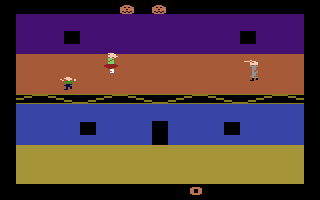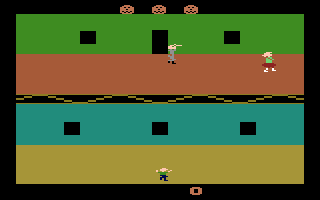Retro Replay Review
Gameplay
The core of Halloween’s gameplay hinges on a delicate balance between protective strategy and tense evasion. Players step into the shoes of Laurie Strode, tasked with shepherding frightened children through a sprawling, two-story house riddled with dangerous blind spots and unexpected dead ends. Each level challenges you to locate safe rooms, lead five children to safety, or take the fight directly to Michael Myers by stabbing him twice. The dual victory conditions keep the pacing fresh: do you play defensively and focus on rescue, or adopt a more aggressive stance when you find the knife?
(HEY YOU!! We hope you enjoy! We try not to run ads. So basically, this is a very expensive hobby running this site. Please consider joining us for updates, forums, and more. Network w/ us to make some cash or friends while retro gaming, and you can win some free retro games for posting. Okay, carry on 👍)
Exploration is both rewarding and nerve-wracking. The game’s map spans sixteen distinct rooms, many of which can plunge into darkness at random intervals. These blackouts heighten the suspense—sudden silence gives way to the faint strains of the iconic Halloween theme, signaling that the killer is near. Players must learn room layouts, memorize shortcuts, and keep track of hiding spots to avoid a fatal encounter. Dead-ends force split-second decisions: do you risk backtracking through a hallway or hunker down and hope the shadows conceal you?
Laurie’s only offensive option is a single knife, hidden somewhere in the house. Once armed, you gain a brief window of empowerment: Michael Myers will still pursue, but a well-timed strike can incapacitate him long enough to rescue the remaining children or dash to the exit. This mechanic injects an element of risk-versus-reward, as you must decide whether to hunt the killer or continue your protective mission. The repeated cycle of rescue attempts, knife hunts, and narrow escapes provides a loop that feels satisfying to master.
Graphics
Visually, Halloween adopts a classic pixel-art style that evokes nostalgic memories of early survival-horror titles. The house’s interior is rendered in moody shades of grey, blue, and black, with flickering lights that enhance the atmosphere of dread. Room details—like scattered toys, overturned chairs, and stained walls—convey a lived-in yet ominous environment. Character sprites for Laurie and the children are simple but expressive, their movements communicating fear and urgency in every step.
Lighting plays a pivotal role in setting the tone. Intermittent blackouts aren’t just a gameplay mechanic; they transform the house into a character of its own. During these moments, corridors vanish into shadow, forcing players to rely on sound cues and memory. When the power returns, you only get fleeting glimpses of the sprawling layout, making each decision feel weighty. The silhouette of Michael Myers, illuminated only by a flickering bulb or the reflection of a knife blade, is enough to send chills down your spine.
Despite its retro aesthetic, the game’s animations are smooth, and environmental indicators—like blood spatters and broken furniture—are clearly visible. The UI is minimalist, displaying only essential information: number of children rescued, current room name, and knife status. This keeps the screen uncluttered, allowing the oppressive ambiance to take center stage. While purists may crave ultra-realistic graphics, the chosen style effectively pays homage to the source material and sticks to its horror roots.
Story
Halloween’s narrative is a direct continuation of the classic slasher film, beginning the moment Michael Myers escapes from the mental institution. Players become Laurie Strode, the babysitter who must stand between innocent children and a faceless killer on a mission of revenge. Though the plot is deceptively simple, it remains faithful to the original’s themes of vulnerability, isolation, and relentless pursuit.
Each rescued child reacts to Laurie’s presence with a mixture of relief and terror, accompanied by brief, evocative dialogue snippets that heighten the emotional stakes. The house itself becomes an extension of Michael’s malevolent intent, its layout shifting metaphorically as the killer draws closer. While there are no lengthy cutscenes or elaborate backstories, the unfolding tension tells a compelling tale: one woman’s fight to protect life against an embodiment of pure evil.
The decision to limit narrative exposition works in the game’s favor, allowing players to fill in the blanks with their own imaginations. Occasional in-game text—scrawled notes left by previous victims, flickering newspaper clippings—offers morsels of lore without derailing the pacing. By focusing on moment-to-moment scares and quick rescue missions, Halloween preserves the essence of the movie’s suspense, delivering a story that’s as straightforward as it is effective.
Overall Experience
Halloween excels at creating a tense, adrenaline-fueled experience that will appeal to fans of classic horror and survival games alike. The combination of stealth, rescue objectives, and timed knife hunts keeps each play session unpredictable. Even after multiple runs, players will find new routes through the house and fresh strategies for outwitting Michael Myers.
The audio design is particularly noteworthy, with the haunting theme music serving as both a warning siren and a catalyst for panic. Ambient creaks, distant screams, and the relentless sound of heavy breathing immerse you in a nightmare scenario. It’s a masterclass in auditory tension, demonstrating how a few well-timed cues can elevate simple gameplay into a truly harrowing experience.
While some may find the retro graphics and straightforward objectives less appealing compared to modern survival-horror epics, Halloween’s strengths lie in its focused design and unwavering commitment to atmosphere. The game offers solid replay value through score-based challenges (rescuing more than five children under time constraints) and the satisfaction of finally cornering Michael Myers. For anyone seeking a compact, high-tension horror title that pays homage to a cinematic classic, this game is a must-play.
 Retro Replay Retro Replay gaming reviews, news, emulation, geek stuff and more!
Retro Replay Retro Replay gaming reviews, news, emulation, geek stuff and more!








Reviews
There are no reviews yet.